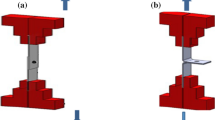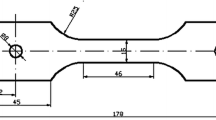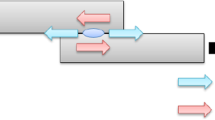Abstract
Several studies have been conducted to predict issues caused by the welding process. The finite element method is extremely useful in analysing this welding process. Generally, in the analysis of welded structures, the welded joint is assumed to be rigid to large structure on vehicle-body crash or fatigue. This assumption does not require a theoretical background of a complicated welding process; therefore, it is relatively easy to set up an analysis model, which significantly reduces the analysis time. However, material properties and mechanical behavior of welded structures cannot be expressed, and there is no sufficient verification for this in several industries. Moreover, few studies have reported on strength analysis, including the welding process; therefore, this study presents a simple modeling using commercial program based on the finite element method. The welding process is simulated by identifying the welding-heat-source variable through experiments and a value close to the measured deposited metal and fusion-zone size are obtained. A flow stress–strain curve based on a uniaxial tensile test is obtained and the tensile strength of the welded specimen is analyzed.















Similar content being viewed by others
References
Rosenthal, D. (1946). The theory of moving sources of heat and its application of metal treatments. Transactions of ASME, 68, 849–866.
Goldak, J., Chakravarti, A., & Bibby, M. (1984). A new finite element model for welding heat sources. Metallurgical transactions B, 15(2), 299–305.
Sun, J., Klassen, J., Nitschke-Pagel, T., & Dilger, K. (2018). Effects of heat source geometric parameters and arc efficiency on welding temperature field, residual stress, and distortion in thin-plate full-penetration welds. The International Journal of Advanced Manufacturing Technology, 99(1), 497–515.
Gery, D., Long, H., & Maropoulos, P. J. J. O. M. P. T. (2005). Effects of welding speed, energy input and heat source distribution on temperature variations in butt joint welding. Journal of Materials Processing Technology, 167(2–3), 393–401.
Azar, A. S., Ås, S. K., & Akselsen, O. M. (2012). Determination of welding heat source parameters from actual bead shape. Computational Materials Science, 54, 176–182.
Yadaiah, N., & Bag, S. (2012). Effect of heat source parameters in thermal and mechanical analysis of linear GTA welding process. ISIJ international, 52(11), 2069–2075.
Tseng, K. H., & Huang, J. M. (2013). Arc efficiency assisted finite element model for predicting residual stress of TIG welded sheet. Journal of Computing, 8(9), 2182–2189.
Arumugam, A., & Pramanik, A. (2020). Review of experimental and finite element analyses of spot weld failures in automotive metal joints. Jordan Journal of Mechanical & Industrial Engineering, 14(3), 315–337.
Nielsen, C. V., Zhang, W., Perret, W., Martins, P. A., & Bay, N. (2015). Three-dimensional simulations of resistance spot welding. Proceedings of the Institution of Mechanical Engineers, Part D: Journal of Automobile Engineering, 229(7), 885–897.
Ma, Y., Yu, Y., Geng, P., Ihara, R., Maeda, K., Suzuki, R., Suga, T., & Ma, N. (2021). Fracture modeling of resistance spot welded ultra-high-strength steel considering the effect of liquid metal embrittlement crack. Materials & Design, 210, 110075.
Deng, X., Chen, W., & Shi, G. (2000). Three-dimensional finite element analysis of the mechanical behavior of spot welds. Finite Elements in Analysis and Design, 35(1), 17–39.
Panda, S. K., Sreenivasan, N., Kuntz, M. L., & Zhou, Y. (2008). Numerical simulations and experimental results of tensile test behavior of laser butt welded DP980 steels. Journal of Engineering Materials and Technology. https://doi.org/10.1115/1.2969256
Kim, D. H., Kim, D. Y., Lee, K. T., & Kim, H. Y. (2012). Strength analysis of MIG welding specimen considering weld characteristics. In Conference on the sector of the Korean Society of Automotive Engineers, Ilsan, Korea (pp. 1195–1201).
Chen, B. Q., & Soares, C. G. (2021). Experimental and numerical investigation on welding simulation of long stiffened steel plate specimen. Marine Structures, 75, 102824.
Hou, Z., Kim, I. S., Wang, Y., Li, C., & Chen, C. (2007). Finite element analysis for the mechanical features of resistance spot welding process. Journal of Materials Processing Technology, 185(1–3), 160–165.
Zargar, S. H., Farahani, M., & Givi, M. K. B. (2016). Numerical and experimental investigation on the effects of submerged arc welding sequence on the residual distortion of the fillet welded plates. Proceedings of the Institution of Mechanical Engineers, Part B: Journal of Engineering Manufacture, 230(4), 654–661.
Kiran, D. V., Cheon, J., Arif, N., Chung, H., & Na, S. J. (2016). Three-dimensional finite element modeling of pulsed AC gas metal arc welding process. The International Journal of Advanced Manufacturing Technology, 86(5), 1453–1474.
Cheon, J., & Suck-Joo, N. (2016). (2016) Influence of simulation methods of temperature distribution on thermal and metallurgical characteristics in GMA welding. Materials & Design, 108, 183–194.
Nezamdost, M. R., Esfahani, M. R., Hashemi, S. H., & Mirbozorgi, S. A. (2016). Investigation of temperature and residual stresses field of submerged arc welding by finite element method and experiments. The International Journal of Advanced Manufacturing Technology, 87(1), 615–624.
Choudhary, B. K., Christopher, J., Palaparti, D. R., Samuel, E. I., & Mathew, M. D. (2013). Influence of temperature and post weld heat treatment on tensile stress–strain and work hardening behaviour of modified 9Cr–1Mo steel. Materials & Design, 52, 58–66.
Choung, J. M., Shim, C. S., & Kim, K. S. (2011). Plasticity and fracture behaviors of marine structural steel, Part I: Theoretical backgrounds of strain hardening and rate hardening. Journal of Ocean Engineering and Technology, 25(2), 134–144.
Gambirasio, L., & Rizzi, E. (2016). An enhanced Johnson-Cook strength model for splitting strain rate and temperature effects on lower yield stress and plastic flow. Computational Materials Science, 113, 231–265.
Murugesan, M., & Jung, D. W. (2019). Johnson Cook material and failure model parameters estimation of AISI-1045 medium carbon steel for metal forming applications. Materials, 12(4), 609.
Choi, I., Eom, J. G., & Joun, M. (2009). Analysis of the tensile test by the rigid-plastic finite element method.
Yadav, S., Singhal, S., Jasra, Y., & Saxena, R. K. (2020). Determination of Johnson-Cook material model for weldment of mild steel. Materials Today: Proceedings, 28, 1801–1808.
Mirone, G., & Barbagallo, R. (2021). How sensitivity of metals to strain, strain rate and temperature affects necking onset and hardening in dynamic tests. International Journal of Mechanical Sciences, 195, 106249.
Acknowledgements
This work was supported by the National Research Foundation of Korea (NRF) Grant funded by the Korea government (MSIT) (No. 2021R1A4A1033141) and (No. 2021R1F1A106-4238).
Author information
Authors and Affiliations
Contributions
All authors contributed to this paper. Experiments were performed by Hansol Kim, Geonho Lee, Seungcheol Shin, Hojin You. Data analysis and result considerations were performed by Hansol Kim, Sang-Woo Han, Chulhong Rhie, Gwangmin Kim and Jungho Cho. The first draft of the manuscript was written by Hansol Kim and all authors commented on previous versions of the manuscript. All authors read and approved the final manuscript.
Corresponding author
Additional information
Publisher's Note
Springer Nature remains neutral with regard to jurisdictional claims in published maps and institutional affiliations.
Rights and permissions
Springer Nature or its licensor holds exclusive rights to this article under a publishing agreement with the author(s) or other rightsholder(s); author self-archiving of the accepted manuscript version of this article is solely governed by the terms of such publishing agreement and applicable law.
About this article
Cite this article
Kim, H., Lee, G., Shin, S. et al. Strength Prediction FEM Model Development of Welded Steel Joint. Int. J. Precis. Eng. Manuf. 23, 1399–1409 (2022). https://doi.org/10.1007/s12541-022-00701-7
Received:
Revised:
Accepted:
Published:
Issue Date:
DOI: https://doi.org/10.1007/s12541-022-00701-7




